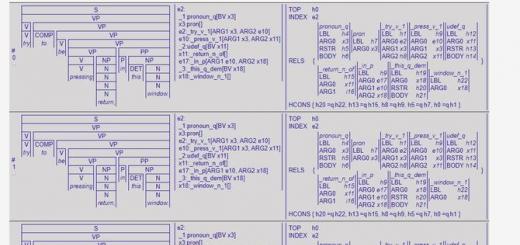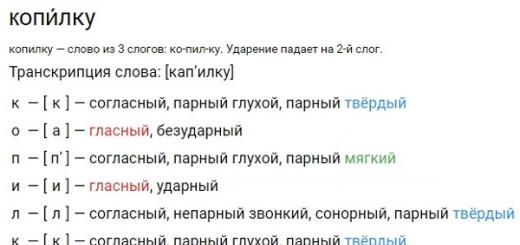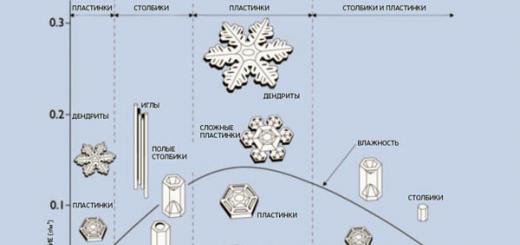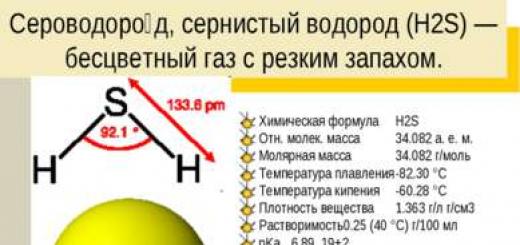Sentence parsing is a detailed analysis of a sentence, divided into several components. Thanks to this method, students will test their knowledge of the syntax of the Russian language. In educational institutions, parsing is the last chapter in the syntax section, since it provides an opportunity to comprehensively use previously acquired knowledge.
How to parse a proposal
Syntactic analysis is a logical and step-by-step process. They use it at school two types of parsing: oral and written. Their difference lies in the fact that in written language the parts of speech are marked schematically, while in oral language they are spoken out.
Step by step analysis:
- Determine what purpose carries a proposal. If the author is trying to tell something - narrative, ask - interrogative, induce to some action - incentive.
- Emotional color in writing is expressed by the presence of an exclamation mark. If you see an exclamation mark at the end, then the sentence is exclamatory. If it is not there, it is non-exclamatory.
- Count the number grammatical basics. One grammatical basis is simple, several are complex.
- Describe The connection between the parts of the sentence is union or non-union.
- Determine how the parts communicate with each other: conjunctions (subordinating or coordinating) or intonation (punctuation marks).
- Depending on the alliances describe the type: compound, complex or non-union.
- Analyze each part for the following parameters: the presence of main and minor members, the search for complicating factors (homogeneous members, introductory constructions, interjections, appeals).
- Make a diagram sentences, graphically highlighting the components.
Note! Syntactic analysis of a complex sentence differs from a simple one only in the number of grammatical bases. Because of this, some steps (step 7) are repeated.
The best services for online analysis
Lexis Res
The Lexis Res website is one of the best services for member-based parsing in English. Main advantage– a detailed description of all the meanings of a single word, which will help users learning English.
The interface consists of two buttons. Team " Analyze" starts the process. The results are available at the bottom of the page. Function " Random sentences» will allow you to get acquainted with the work of the site using the example of a random offer.
pros:
- Detailed parsing.
- No annoying advertising.
- Wide functionality of the service.
- Minimalist interface.
- Extensive base of words.
Minuses:
- The resource is adapted for English expressions only.
- Lack of graphic symbols.
- Without proper knowledge of a foreign language, it will be difficult to read detailed explanations.
Delph-in
The Delph-in service is another English-language resource dedicated to parsing. Uniqueness is that it uses the Linguistic Knowledge Builder programming language, which is used in foreign universities.
Using the Linguistic Knowledge Builder Method provides benefits in terms of detail and its components. The English Resource Grammar technology, which is also used in foreign education, is responsible for visualization. 
Advantages:
- Great for exploring highly focused offerings.
- A huge number of tools for parsing parts of speech.
- There is no limit on the number of characters.
Flaws:
- People with a good command of English will be able to fully work with the service.
- A cumbersome interface that will take time to master.
MorphologyOnline
The MorphologyOnline website is a Russian-language resource dedicated to syntax. The site interface fits into one button. From user required enter the required word, and the program will analyze it.
For the convenience of users, the service provides step-by-step check. In most cases, the verification process is carried out in three stages: identification of the part of speech, morphological features and probable syntactic role. 
pros:
- Detailed analysis.
- Operational operation of the site.
- No advertising.
Minuses:
- Parsing is carried out within one word.
- The main emphasis of the resource is on morphology.
- Narrow specialization.
Gramota.ru
Gramota.ru is a Russian-language site that parses the requested word. Submitted by the service is carried out checks the selected word not only according to syntactic and morphological characteristics, but runs the selected word through all popular dictionaries, including a dictionary of specialized terms. 
Advantages:
- Detailed analysis of a word, including searching for meaning in dictionaries.
- Nice user interface.
- Possibility to choose criteria.
Flaws:
- The program parses one word at a time.
- The site is more focused on morphological analysis.
Goldlit
Goldlit website is one of the best parsing portals. Key Advantage Russian-speaking competitors have the opportunity to analyze entire proposals.
The algorithm of actions is extremely simple: the user enters a phrase or word. The portal processes the information and parses each word separately. Near every member the initial forms of the word, the part of speech to which it belongs, are written, and then grammatical analysis and declension by case are performed. 
pros:
- Detailed syntactic and grammatical analysis.
- There are no restrictions on the topic and number of characters.
- Friendly interface.
- The site is easy to use.
- Additional information on the literature.
Minuses:
- Lack of grammar reference books.
- The service is more focused on literature.
The order of parsing a simple sentence
1. Parse the sentence into members and indicate how they are expressed (first, the subject and predicate are analyzed, then the minor members related to them).
2. Determine the type of sentence according to the purpose of the statement (narrative, incentive, interrogative).
3. Determine the type of sentence by emotional coloring (exclamatory, non-exclamatory).
4. Find the grammatical basis of the sentence and prove that it is simple.
5. Determine the type of sentence by structure:
a) two-part or one-part (definitely personal, indefinitely personal, generalized personal, impersonal, nominal);
b) widespread or not widespread;
c) complete or incomplete (indicate which part of the sentence is missing);
d) complicated (indicate how it is complicated: homogeneous members, isolated members, appeal, introductory words).
6. Draw up a sentence diagram and explain punctuation marks.
Parsing samples
1) My bonfire shining in the fog(A.K. Tolstoy).
The sentence is narrative, non-exclamatory, simple, two-part, common, complete, uncomplicated.
Grammar basis - the fire is shining my expressed by a possessive pronoun. The predicate refers to the adverb of place in the fog expressed by a noun in the prepositional case with a preposition V.
Sentence outline At the end of a given declarative sentence there is a period.
2) At the end of January, surrounded by the first thaw, cherry trees smell good gardens (Sholokhov).
The sentence is narrative, non-exclamatory, simple, two-part, widespread, complete, complicated by a separate agreed definition, expressed by a participial phrase.
Grammar basis - the gardens smell. The subject is expressed by a noun in the nominative case, the predicate is a simple verb, expressed by a verb in the indicative mood. The subject includes an agreed definition cherry expressed as an adjective. The predicate refers to the circumstance of time in the end of January, expressed by the phrase (noun + noun) in the prepositional case with a preposition V, and the circumstance of the course of action Fine expressed by an adverb.
Sentence outline At the end of a given declarative sentence there is a period; commas in the sentence highlight the participial phrase, which, although it stands before the word being defined, is isolated because it is separated from it in the sentence by other words.
Ways to emphasize sentence members
When parsing a sentence into members, standard underlines are used: one line for the subject, two lines for the predicate, a dotted line for the object, a wavy line for the definition, alternating dots and dashes for the circumstance.
In some schools, the main member of a one-part sentence is emphasized with three features, but more common is the underlining, in which the main member of the noun sentence is marked as the subject, and the main members of other one-part sentences are marked as predicates.
When emphasizing the minor members of a sentence, it is advisable to be guided by the following principles.
An isolated member of a sentence is emphasized as a single member.
Accordingly, non-isolated members should be emphasized as detailed as possible in accordance with the questions asked to them.
Designation of words and phrases that are not parts of the sentence
As is known from morphology, auxiliary parts of speech are not parts of a sentence, but during syntactic parsing certain problems can be associated with them.
Conjunctions are not members of a sentence and are not distinguished when homogeneous members are combined, but in some cases they can be part of non-uniform members of a sentence.
Firstly, these are comparative conjunctions as part of comparative phrases, for example: The surface of the bay was like a mirror.
Secondly, these are unions consisting of isolated members of a sentence, for example: Stopping often and for a long time, we got to the place only on the third day.
Prepositions also cannot act as independent members of a sentence, but they are used as part of a prepositional-case group, together with the case form, expressing a certain meaning.
Therefore, it is customary to emphasize the preposition together with the noun to which it refers. In this case, it is necessary to pay attention to cases when the preposition and noun are separated by adjectives or participles, for example: instead of older brother. In this case, it would be a mistake to emphasize the preposition together with the adjective as a modifier; the underscore should be as follows: instead of older brother.
Formative particles are part of compound verb forms and are emphasized together with the verb both in contact and non-contact positions, for example: Let him call me!
Semantic (non-shape-forming) particles are not members of a sentence, however, in school practice, a negative particle is not usually emphasized as a single member of a sentence together with the word to which it refers, for example: No smoking here. I didn't really count on help.
It is permissible not to highlight both prepositions and all semantic particles.
Some teachers teach to highlight conjunctions by circling them, and prepositions by circling them with a triangle. This allocation is not generally accepted.
Introductory words and addresses are not parts of the sentence. Sometimes students enclose these components in square brackets or underline them with crosses. This is undesirable, since underlining is used only to indicate members of a sentence; It is permissible to mark these elements of the sentence by writing the words “introductory” or “address” over them.
Description of the complicating members of the sentence
When a sentence is complicated by direct speech or an inserted sentence, they are considered and described as an independent sentence, since both direct speech and an inserted sentence have their own purpose of utterance and intonation, which may not coincide with the purpose of the utterance and the intonation of the sentence itself.
So, for example, the proposal He asked indignantly: “How long will you continue to dig?!” should be analyzed as follows: the sentence is narrative, non-exclamatory, simple, two-part, common, complete, complicated by direct speech. Direct speech is an interrogative, exclamatory, two-part, extended, complete, uncomplicated sentence.
The participial phrase complicates the sentence only if it is isolated. At the same time, the description should indicate the complication not by a participial phrase, but by a separate definition; in brackets it is possible, but not necessarily, to indicate that it is expressed by a participial phrase.
The comparative phrase can be any member of the sentence - the predicate ( This park is like a forest), circumstance ( The rain was pouring down like buckets), addition ( Petya draws better than Anton), definition (He's almost the same as his brother). In this case, comparative turnover can be either separate or non-separated. Complication is caused only by a separate comparative phrase, and, as in the case of a participial phrase, it is necessary to indicate the complication with a separate circumstance, addition or definition.
Homogeneous members, introductory words and sentences, and addresses are also described as complicating the structure of a sentence.
Sentences with homogeneous predicates present some complexity. In school and pre-university practice, it is believed that a two-part sentence in which the subject is used with several predicates is a simple sentence complicated by homogeneous predicates. In a one-component sentence, there are as many parts as there are predicates in it, with the exception of cases when the structure of the predicate contains homogeneous parts.
For example: I was offended and did not want to answer him- a simple two-part sentence with homogeneous predicates.
I felt offended and didn’t want to answer him.- difficult sentence.
I felt sad and lonely- a simple one-part (impersonal) sentence with homogeneous parts of the predicate.
One-part sentences
When analyzing one-part sentences, students often make various mistakes.
The first type of errors is associated with the need to distinguish between one-part and two-part incomplete sentences.
As already mentioned, we diagnose a definite-personal sentence by the form of the main member: the predicate in it is expressed by a verb in the form of the 1st and 2nd person singular and plural indicative mood (in the present and future tense), and in the imperative mood; the producer of the action is defined and can be called personal pronouns of the 1st and 2nd persons me, you, we, you:
I walk and walk, but I can’t reach the forest.
The peculiarity of verb forms with the morphological feature of the 1st and 2nd person is that each of these forms can “serve” one single subject: a form ending in -у ( go-y) - pronoun I, form with ending -eat/-ish ( go-eat) - pronoun you, form with -em/-im ( let's go) - pronoun we, form with -ete/-ite ( let's go) - pronoun you. Forms 1 and 2 of the imperative mood also clearly indicate the person who is the producer of the action.
Since the morphological feature of a person is represented by a verb only in the indicated forms, sentences of a similar meaning with a predicate-verb in the form of the past tense of the indicative mood and the conditional mood are considered two-part incomplete, for example:
He walked and walked, but never reached the forest.
In this sentence, the form of the predicate does not indicate in any way the producer of the action.
Even if it is clear from the previous context that the producer of the action is the speaker(s) or the hearer(s), sentences or parts of a complex sentence without a subject with a predicate in the past tense or in the conditional mood should be characterized as two-part incomplete, since information about the producer of the action is extracted not from the sentence itself, but from the previous context, which, in fact, is an indicator of the incompleteness of the sentence or part of it; see, for example, the second part of a complex sentence:
I would help you if I knew how.
In indefinite-personal sentences, as already mentioned, the main member is expressed by a verb in the 3rd person plural form (present and future tense in the indicative mood and in the imperative mood), the plural form of the past tense of the indicative mood or a similar form of the conditional mood of the verb. The producer of the action in these sentences is unknown or unimportant:
They are calling you / they called / let them call / they would call you.
Such sentences without a subject with a predicate in the indicated forms, in which the producer of the action is known from the previous context, are not indefinitely personal; see for example the second sentence in the following context:
We left the forest and tried to get our bearings. Then we walked along the path to the right.
Such sentences are also two-part incomplete.
Thus, when characterizing a sentence as a single-component definite-personal, it is necessary to remember the restrictions on the form of the predicate; when diagnosing a sentence as indefinite-personal, it is also necessary to take into account the meaning - an indication that the performer of the action is unknown.
Generalized personal one-part sentences include not all one-part sentences that report an action that can be attributed to everyone, but only those in which the predicate is expressed in the 2nd person singular form of the indicative and imperative moods or the 3rd person plural indicative form moods:
The forest is being cut down and the chips are flying.
However, in a generalized personal meaning, definitely personal sentences with the main member in the form of 1st person and impersonal sentences can be used: What we have, we don’t keep; when we lose it, we cry; If you're afraid of wolves, don't go into the forest. Nevertheless, such proposals are not usually characterized as generalized and personal.
The greatest difficulties are associated with parsing an impersonal sentence.
It is very difficult to determine the composition of the main members in sentences like We had a lot of fun going down this slide., i.e. in sentences containing a copula, a nominal part and an infinitive. There are two traditions in the analysis of such proposals.
There is an opinion that when characterizing such sentences as impersonal or two-part, it is not the sequence of components that is important (the infinitive at the beginning of the sentence or after the copula and the nominal part), but the meaning of the nominal part of the predicate.
So, if in the nominal part an adverb is used with the meaning of the state experienced by the performer of the action (fun, sad, hot, cold, etc.), then this is a one-part impersonal sentence:
It was fun going down this slide.
It was fun to ride down this slide.
If in the nominal part a word is used with the meaning of a positive or negative evaluation (good, bad, harmful, useful, etc.), then we have a two-part sentence with a subject, an expressed infinitive:
It was harmful for him to smoke.
Smoking was bad for him.
According to another linguistic tradition, the characteristics of a sentence of this type depend on the order of the words in it, and not on the meaning of the word in the nominal part. If the infinitive comes before the connective and the nominal part, then, given the relatively free order of words in the Russian language, it denotes the subject of the message and is the subject:
Smoking was bad for him.
If the infinitive follows the copula and the nominal part, then we have an impersonal sentence:
It was harmful for him to smoke.
With regard to impersonal sentences, it is also necessary to note the following: not impersonal, but two-part incomplete, it is customary to consider parts of a complex sentence in which the subject position is replaced by an explanatory clause or direct speech, for example:
You could hear the gate creaking a (compare: It was audible).
“I’m lost,” flashed through my head.(compare: It flashed through my head).
Such sentences without a subordinate part or direct speech lose all meaning and are not used, which is a criterion for the incompleteness of the sentence. Thus, the sentences *It was heard or *It flashed through my head cannot be understood and are not used.
The order of parsing a simple sentence
1. Determine the type of offer according to the purpose of the statement
(narrative, incentive, interrogative).
2. Determine the type of offer by emotional coloring
(exclamation, non-exclamation).
3. Find the grammatical basis of a sentence
and prove that it is simple.
4. Determine the type of sentence by structure:
A) two-part or one-part(definitely personal, indefinitely personal, generalized personal, impersonal, nominal);
b) widespread or not widespread;
V) complete or incomplete(indicate which part of the sentence is missing);
d) complicated (indicate how it is complicated: homogeneous members, isolated members, appeal, introductory words).
5. Parse the proposal by members and indicate how they are expressed(first, the subject and predicate are analyzed, then the secondary members related to them).
6. Draw up a sentence diagram and explain punctuation marks.
1) My fire is shining in the fog(A.K. Tolstoy).
The sentence is narrative, non-exclamatory, simple, two-part, common, complete, uncomplicated. Grammar basis - the fire is shining my expressed by a possessive pronoun. The predicate refers to the adverb of place in the fog expressed by a noun in the prepositional case with a preposition V.
Proposal outline. At the end of this declarative sentence there is a period.
2) At the end of January, surrounded by the first thaw, the cherry orchards smell good(Sholokhov).
The sentence is narrative, non-exclamatory, simple, two-part, widespread, complete, complicated by a separate agreed definition, expressed by a participial phrase. Grammar basis - the gardens smell. The subject is expressed by a noun in the nominative case, the predicate is a simple verb, expressed by a verb in the indicative mood. The subject includes an agreed definition cherry expressed as an adjective. The predicate refers to the circumstance of time in the end of January, expressed by the phrase (noun + noun) in the prepositional case with a preposition V, and the circumstance of the course of action Fine expressed by an adverb.
Sentence scheme [,]. At the end of this declarative sentence there is a period; commas in the sentence highlight the participial phrase, which, although it stands before the word being defined, is isolated because it is separated from it in the sentence by other words.
Parsing a simple sentence
A simple sentence can be parsed as follows:
According to the purpose of the statement:
- narrative,
- interrogative,
- motivating.
By intonation:
- non-exclamatory
- exclamation point.
In terms of the number of grammatical bases - simple,
By the presence of one or both main members:
1) two-part.
2) one-piece. With the main dick
a) subject - nominative;
b) predicate:
- definitely personal
- vaguely personal,
- generalized-personal,
- impersonal.
By the presence of minor members:
- common,
- not widespread.
By the presence of missing members:
- complete,
- incomplete (indicate which member(s) of the sentence is/are missing).
According to the presence of complicating members:
1) uncomplicated,
2) complicated:
- homogeneous members of the sentence;
- isolated members of the sentence;
- introductory words, introductory and plug-in constructions,
- direct speech;
- appeal.
Underline the parts of the sentence.
Indicate the type of predicate(s): ASG, SGS, SIS.
Make a descriptive analysis according to the following scheme:
Here is an example of parsing a simple sentence.
Sample parsing a simple sentence:
Doorman, came out at that moment from the door of the restaurant hanger into the yard to smoke, trampled on the cigarette and moved towards the ghost with the obvious purpose of blocking his access to the restaurant, but for some reason he did not do this and stopped, smiling stupidly (M. A. Bulgakov).
In the Russian language, the process of syntactic analysis is considered to be an alternating comparison of words with the selection of a certain subset from the set of all words. The result is syntactic sequencing, which is used in conjunction with lexical analysis. Syntactic analysis makes it possible to analyze the structure of a sentence, which increases the level of punctuation literacy.
It is acceptable to perform parsing in both simple and complex sentences, as well as phrases. Each example has its own analysis scenario, which emphasizes its inherent components. When parsing, you must have the ability to isolate phrases from sentences, as well as determine whether a sentence is simple or complex. In addition, you should understand how the phrase is constructed and assign it a connection type. There are the following types of communication: coordination, adjacency, control. When parsing, we need to select the desired phrase in a sentence, then set the main word. The next step is to determine the tense, mood, and person and number of the main word. As for the analysis of a simple sentence, it is necessary to initially determine it by the purpose of the statement, namely, whether it is narrative, imperative or interrogative. Then you need to find the subject and predicate. The next step is to determine the type of sentence - it is one-part or two-part. Afterwards, we find out whether the sentence contains words in addition to the subject and predicate, which will allow us to say whether it is common or not common. Next there will be an establishment - a complete or incomplete sentence. Let's look at this example: “I have never listened to music more beautiful than Beethoven.” We will consider the proposal simple. Endowed with one grammatical basis - “I didn’t listen.” “I” is the subject, personal pronoun. “Didn’t listen” is a simple verb, a predicate, which includes the particle “not.” The sentence contains the following minor members “music” - an object expressed by a noun. “More beautiful” is a definition expressed by an adjective in the comparative degree. "Beethoven" is an object, a noun. Now we can characterize this sentence - it is declarative, not exclamatory; in structure - simple, since there is one grammatical basis; two-part - there are both main members; widespread - because it contains secondary members; complete - no missing members. There are also no homogeneous members in the sentence.

Using the sequence and rules of syntactic analysis, it will not be difficult to correctly parse a sentence, although in terms of parsing speed you will most likely be surpassed by a good sixth-grader.
Today we continue to study a complex sentence, in this lesson we will learn how to parse it.
1. Determine the type of sentence according to the purpose of the statement ( narrative, interrogative, incentive).
2. Determine the type of sentence by intonation ( exclamation, non-exclamation).
3. Identify simple sentences within complex ones and determine their bases.
4. Determine the means of communication of simple sentences in a complex one ( allied, non-union).
5. Highlight the minor members in each part of a complex sentence, indicate whether it is common or uncommon.
6. Note the presence of homogeneous members or appeals.
Proposition 1 (Fig. 1).
Rice. 1. Sentence 1
The sentence is narrative, non-exclamatory, complex (has two grammatical stems), conjunctive (connected by the conjunction And), both the first and second parts are not widespread (Fig. 2).
Rice. 2. Analysis of sentence 1
Proposition 2 (Fig. 3).

Rice. 3. Proposition 2
The sentence is narrative, non-exclamatory, complex, non-conjunctive. The first part is common (there is a definition), the second is not common (Fig. 4).
 Rice. 4. Analysis of sentence 2
Rice. 4. Analysis of sentence 2
Parse the sentence (Fig. 5).
Rice. 5. Offer
The sentence is narrative, non-exclamatory, complex, conjunction. The first part is common, complicated by homogeneous predicates. The second part is common.
Rice. 6. Analysis of the proposal
Bibliography
1. Russian language. 5th grade. In 3 parts Lvova S.I., Lvov V.V. 9th ed., revised. - M.: 2012 Part 1 - 182 p., Part 2 - 167 p., Part 3 - 63 p.
2. Russian language. 5th grade. Textbook in 2 parts. Ladyzhenskaya T.A., Baranov M.T., Trostentsova L.A. and others - M.: Education, 2012. - Part 1 - 192 pp.; Part 2 - 176 p.
3. Russian language. 5th grade. Textbook / Ed. Razumovskoy M.M., Lekanta P.A. - M.: 2012 - 318 p.
4. Russian language. 5th grade. Textbook in 2 parts Rybchenkova L.M. and others - M.: Education, 2014. - Part 1 - 127 p., Part 2 - 160 p.
1. Website of the festival of pedagogical ideas “Open Lesson” ()
Homework
1. What is the procedure for parsing a complex sentence?
2. What are complex sentences for the means of communication between parts?
3. Underline the grammatical basics in the sentence:
The hasty dawn was approaching, the heights of heaven brightened.










